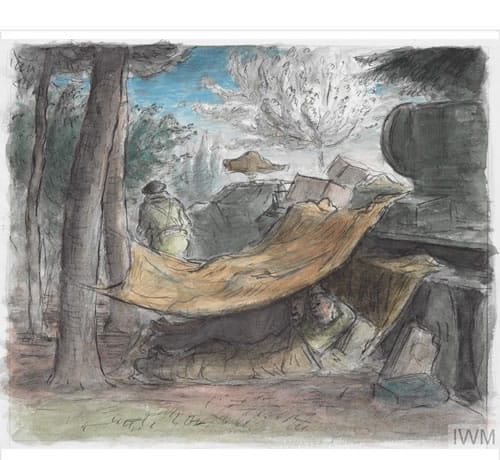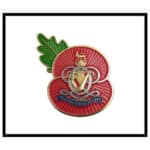The following extracts are taken from a diary kept by Lieutenant Colonel C. Goulburn then commanding the 8th Hussars.
By last light, 26th August 1944, the Regiment, which had crossed the River Risle at Pont Authou, had reached the village of St.Leger Du Gennetey, where enemy opposition was encountered on the line of the railway which runs East and West through that place. Lt Col Goulburn was ordered to push Northwards at first light the next morning with the task of cutting the road running North-East from Routot in the neighbourhood of Hautville. He ordered his Regiment to advance two squadrons up. Right ‘C’ Squadron (Major Henry Huth), left ‘B’ Squadron (Major John Gwynn), and a reserve ‘A’ Squadron (Major Bob Ames).
27th August. I go up to each Squadron in turn soon after first light. Both are across the railway near St. Leger Du Gennetey, but ‘B’ Squadron has been delayed by trees fallen across the road. They are clearing them with the help of Russian prisoners of war whom they have just captured. Return to Regimental HQ for some breakfast and soon afterwards visit both squadron HQs again. ‘C’ Squadron is now held up by anti-tank fire coming from the line of the main road running from Bourg Achard to Rougemontiers. A lot of spandau fire is coming, too, from the direction of a big beech wood near the Chateau St. Hilaire. After a ‘softening up’ of the beechwood by ‘J’ Battery Royal Horse Artillery, together with HE fire from our own tanks which had set on fire every farm building and house on that road, I order both Squadrons to advance again, staying myself at ‘C’ Squadron HQ to watch the progress of the attack.
‘C’ Squadron on the right is advancing two troops up. The right troop gets across the road but one of its tanks is knocked out in doing so. The left troop reaches an orchard just south of the road and is again pinned down. ‘B’ Squadron on the left of ‘C’ is also advancing two troops up, the left troop advancing towards the Chateau which is out of sight behind the beech wood. Soon afterwards this troop goes off the air and half an hour later a dishevelled soldier arrives on foot at Squadron HQ. He reports that two of the three tanks in his troop have been knocked out, that of his troop leader, Lt Apthorpe, having been ‘brewed’. He clambered out but he is certain that Apthorpe had been killed inside the tank before it caught fire. He had crawled across a field being sniped. He thought the crew of the other tank, that of his troop sergeant, had got out alive so there is some hope of them turning up.
At about 7 pm I receive orders from Brigade HQ not to attempt any further advance because the 7th Battalion Argyll and Sutherland Highlanders are being sent up to attack the woods and the Chateau. In fact, the leading elements of this infantry Battalion do not arrive until 9 pm; too late to carry out any preliminary reconnaissance or to plan an attack before darkness sets in. At last light, the farms along the road westwards from Bourg Achard are still burning. It is a proper battle scene. I am ordered to withdraw back to Flancourt for the night as soon as the infantry has taken over the forward position which we have reached today.
28th August. During the night the enemy has withdrawn from his position of yesterday, and the Regiment has been placed into Divisional reserve with the unlikely event of any move this morning. I have time, therefore, to go back to the scene of yesterday’s battle to look for Apthorpe and any of the two crews who may be wounded. No bodies in the two tanks, not even those white ashes which are usually distinguishable inside a tank that has been burnt out. We form a line and walk through a potato field in which his tank is located and through which he or the other wounded men might have crawled. The potato tops are knee-high and very thick. It reminds me of walking up partridges! Nobody found. Then we search the beech wood, and finally, call on the Chateau.
The owners, the Count and Countess du Chaste are there, and they invite us in. The Countess, a charming lady, tells me that the Germans brought five British soldiers into her house that night, one of whom was badly wounded. She had done what she could for him as the Germans had no doctor or medical supplies. I question her closely as to whether one of the prisoners could have been an Officer, but she was unable to give a definite answer. She says a German Officer had played the piano in the Salon during the shelling the previous afternoon (he must have been very brave or very mad). She and her household had sensibly gone to ground in the cellar.
The Chateau is a fine old house full of beautiful furniture. Despite our heavy shelling of the beech wood, which is only a hundred yards away, the Chateau itself miraculously has suffered only one direct hit knocking a big hole in the roof. The nearby stables and outhouses, however, have been very badly damaged and are a shambles. The beech trees have been mostly de-capitated, the shells bursting on impact with the tops of the trees.
Orders are now received that the Division is concentrating back at St. Georges Du Vievre. We cross the River Risle at Montfort at about 7 pm and leaguer for the night about three miles South-West of St.Georges. One of our spitfire fighters comes up suddenly and silently from the flank and nearly knocks off the aerial mast of my scout car. It makes a forced landing in a big stubble field, its propeller flying off for 200 yards. The pilot gets out, shaking all over and says he has been shot down at 30,000 feet. We revive him with a cup of tea and some food.
29th August. A 30 mile march Eastwards again, across the Risle at Fontaine La Soret; by-passing Le Neubourg and into leaguer just South-West of Louviers near Quatremaret and close to a big Chateau. I call on the owners accompanied by Henri Belmont, our French Liaison Officer. They apologise for not being able to offer us a glass of wine as they say the Germans have drunk the lot. Papa is a retired French landowner. Mama speaks English quite well. Their house is huge, and I would think they are impoverished landowners.
I am called to Division HQ for a conference which is held in the Salon of a really beautiful Chateau and a famous one I believe. The Division is to cross the Seine tomorrow and to move on three parallel routes in a North-East direction. Pouring with rain and I go to ground under a tarpaulin for the night.
30th August. Up at 5 am. Pitch dark and a cold wind, but the rain has stopped. No breakfast as fires are not allowed to be lit in the dark. Pass through Louviers but progress very slow as traffic congestion is appalling. At last, at 3.15 pm we cross the Seine by a pontoon bridge erected by our Engineers at St. Pierre Du Vauvrey. Once clear of this bridge we pass on quickly through Les Andelys, Gournay-En-Bray to Grumesnil which we reach just as it was getting dark. As I turn into leaguer in a big field I can see some German horse-drawn transport pulling out hastily at the far end. Too dark to do anything about them.
We are nearly out of petrol and we have no maps of the country through which we are to advance tomorrow. But petrol and maps, however, arrive during the night. Orders for tomorrow are to lead the advance and to seize a crossing over the River Somme.
31st August. Off at 6.45 am. Order of march: ‘A’ Squadron, Regimental tactical HQ; ‘D’ Battery (Major Jack Tyrell); ‘C’ Squadron; RHQ less my tactical HQ; ‘B’ Squadron. No opposition and we will travel at a great pace passing through Formerie — Sarcus — St. Clair — Frettermolle — Marlers — Eplessier — Lamaronde — St . Aubin Montenoy — Camps En Amienos.
As we rush through the villages bunches of wet Chrysanthemums and unripe apples and pears are thrown at us, I receive direct hits on several occasions. This is more dangerous than the Germans today!
We pass parties of the French Marquis who are scouring the woods for exhausted German soldiers who have got off the roads and taken to the countryside. Shots can be heard from time to time and the Marquis are thoroughly enjoying themselves. It reminds me of a farmers rabbit shoot on a Boxing Day holiday. We pass parties of wounded and footsore German soldiers being made to run along the road by excited and angry captors. Not a very pretty sight. But allowance must be made for a people who have suffered from years of enemy occupation.
We reach the Somme after travelling 80 miles in 8 hours. Not a bad gallop for a Regiment of Cromwell tanks. My leading tanks report that the road bridges to its East have all been blown. We have run out of maps of the country North of the Somme. But they arrive during the night, so does the petrol. I am called to a Brigade HQ conference at 9 pm. We are in for a short night march as a bridge has been found 20 km downstream of Amiens which is said to be only partly demolished and will take tanks. Off at 10 pm on a cloudless night and with a full moon. Cross the river by this bridge, a wooden one by a lock, and go into leaguer at 12.30 am.
1st September. Lie down at 2 am exhausted with orders to attend a Brigade Conference at 4.45 am.
1st September. A sudden change in the weather. Pitch dark and pouring with rain. The objective for today is St.Pol. Return to my HQ to a breakfast of tepid bacon and potatoes mixed with rainwater.
QRIH Journal 1981



